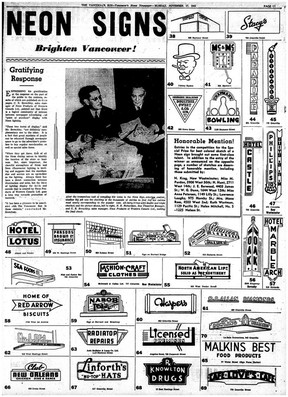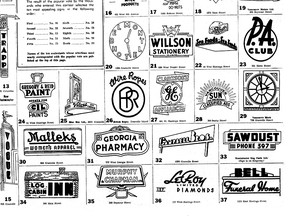Neon signs were so popular in Vancouver in 1941 The Vancouver Sun had a contest to pick the best one

Article content
Neon signs were all the rage in 1941. Giant “blade” signs went up alongside theatres, department stores and hotels. Small but intricate signs went up on countless small businesses.
On Nov. 10, 1941, The Vancouver Sun decided to launch a contest for readers to pick their favourites. Well, sort of — all 69 signs depicted in the contest were by Neon Products, which probably sponsored the contest.
Advertisement 2
Article content
The paper printed two pages of illustrations of neon signs, and readers were asked to pick their faves, ranked one to 10.
The reader whose picks were closest to the overall list would win $25. Second place was $10; third, $5; fourth, $3; fifth, $2. If you were 6th to 10th, you won a buck.
There was also a $10 prize for best “coloured drawing” of a sign, which was presumably for kids — the newspaper pages looked like a colouring book. The winners were announced Nov. 17.

Almost all the signs in the contest are now gone, as are the businesses where they hung outside. But there were really nifty designs.
The Blue Boy ice cream parlour had “Blue Boy” at the top and “Velvet ice cream” on a round base, with Velvet in script. The tall metal “can” above the base featured a reproduction of the famous Thomas Gainsborough painting, presumably lit up by a neon frame that surrounded it.
The Log Cabin Inn sign was a simple design of a log cabin. The establishment was quite infamous in its day because it was the scene of a murder in 1942. It was also managed by Buddy White, who ran a gambling joint in Hogan’s Alley for many years.
Article content
Advertisement 3
Article content
The Sun was represented by its classified ad sign, which had sunbursts flaring out of the top and a curving arrow at the bottom pointing to the entrance of the classified advertising section.

The Sun sign took second place in the contest. The winner was a fairly pedestrian sign of Winston Churchill smoking a cigar in his derby hat and bow tie.
Its popularity was probably due to Churchill’s fame during the Second World War, which was raging at the time. And the sign had a unique history.
“It starts up on Georgia Street at the courthouse Christmas tree,” said neon expert John Atkin. “They illuminated the Christmas tree with neon ornaments.”
It seems to have used a lot of electricity. A Sun story on Dec. 18, 1940 said when they turned on the sign it blew fuses in the courthouse, and trials had to be put on hold until the fuses were replaced.
The Churchill sign was supposed to be temporary, but in Jan., 1941 it was moved to Victory Square, where it sat atop a recruiting station for the armed forces.

Two neon signs that made the list still exist: the Vogue Theatre and the Vancouver Block.
Advertisement 4
Article content
The Vogue is a classic blade sign that flows down the front of the building, topped by Diana, the Roman goddess. The Vancouver Block features a neon clock, which has been a downtown landmark since neon was added to an existing clock in 1927.
The Vancouver Archives has photos of many of the neon signs in the Sun contest, as well as of later signs. The Williams Bros. did a series of neon shots in 1948 and 1949 that include a marvellous black and white montage featuring neon signs for the Sun, the Province, the Vogue and Capitol theatres, Wosk’s, Jordan’s and Boomer carpets.
After the war, Atkin said there were about a dozen companies making neon signs in Vancouver, when signs like the Niagara Hotel’s cascading waterfall were made.

Incredibly, the original design for the Niagara Hotel neon waterfall just turned up, and recently was added to the Vancouver Archives website.
The Pattison Sign Group (which was formerly Neon Products) has donated a trove of “flimsy files” dating from 1945 to 1964. A post on the Archives’ AuthentiCity blog describes flimsies as “small sketches of designs with basic production information.”
Advertisement 5
Article content
“They’re so cool,” said archivist Heather Gordon. “Business records are sometimes hard to come by, especially records that show design work by firms that build things. If we can get concept drawings, that’s really amazing.”




Recommended from Editorial
-

he Nov. 17, 1927, Vancouver Sun had an astonishing 35 stories on its front page. A Vancouver judge was promising “no mercy for drug dealers,” a citizen had been shot in the leg and hand by a mysterious prowler, and Hollywood star Marie Prevost was divorcing her actor husband Kenneth Harlan after he hosted a 4 a.m. “bathing suit party” in their home. One of the most intriguing stories is crammed in between the ads on Page 10: “Use of Neon Gas Signs is Legalized.”
-

The City of Vancouver has decided to trash the iconic neon sign from the Balmoral Hotel.
Article content




Comments